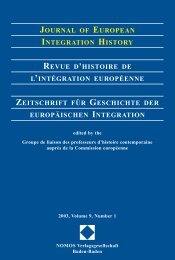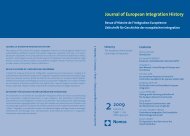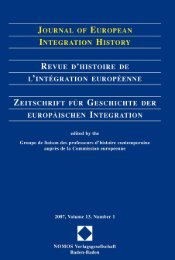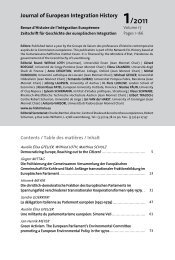journal of european integration history revue d'histoire de l ...
journal of european integration history revue d'histoire de l ...
journal of european integration history revue d'histoire de l ...
You also want an ePaper? Increase the reach of your titles
YUMPU automatically turns print PDFs into web optimized ePapers that Google loves.
94<br />
Hans-Otto Frøland<br />
The interest for fish exports conflicted with the interest in avoiding agricultural imports.<br />
The Norwegian negotiators therefore actively contributed to and were quite<br />
satisfied when early in 1958 OEEC negotiators segregated the discussions on agriculture<br />
and fisheries. 51 Prior to the break in the FTA negotiations, in November<br />
1958, the minister <strong>of</strong> Tra<strong>de</strong> was pleased to state that the fisheries scheme appeared<br />
to be no more liberal than Norway would like it to be:<br />
“If we had gone on to <strong>de</strong>mand absolute free tra<strong>de</strong> it would not have been possible to<br />
avoid placing a number <strong>of</strong> our national Norwegian regulations (…) in the spotlight<br />
immediately”. 52<br />
The authorities gave higher priority to the national regulations <strong>of</strong> the primary sector<br />
than to fish exports. However, eventually recognising that agriculture could not be<br />
exclu<strong>de</strong>d from any agreement, the government primarily sought to gain un<strong>de</strong>rstanding<br />
for bilateral special schemes that would have the greatest possible protective<br />
effect. In April 1958 the government had agreed to a Swedish initiative for a<br />
separate Scandinavian plan that accepted the EEC <strong>de</strong>finition <strong>of</strong> agricultural produce<br />
(Annex II <strong>of</strong> the Treaty establishing the EEC), with the exception <strong>of</strong> some fish<br />
goods. The plan established via bilateral contingencies a minimum-price system<br />
corresponding to the aim <strong>of</strong> the EEC Treaty. 53 In the autumn <strong>of</strong> 1958 the Norwegian<br />
government was also inclined to accept a time schedule for introducing multilateral<br />
regulation.<br />
This proves that some groups in the government were willing to restructure agriculture.<br />
Some believed that agricultural protection could not be <strong>de</strong>fen<strong>de</strong>d if impeding<br />
participation in the European free tra<strong>de</strong> area, and that the agricultural policy<br />
had become too inflationary anyway. However, resistance against a change remained<br />
strong within the government itself, as well as in parliament and, no doubt,<br />
among agricultural organisations. Agricultural organisations wanted to set the minimum-price<br />
scheme <strong>of</strong> the Scandinavian plan at a level that would not force radical<br />
changes. Had a FTA treaty comprising agriculture been negotiated, a strong domestic<br />
opposition would have occurred. Referring to an inter-Scandinavian report from<br />
1957 that argued in favour <strong>of</strong> a Nordic common market which covered eighty per<br />
cent <strong>of</strong> intra-Scandinavian tra<strong>de</strong> while simultaneously omitting agriculture, opponents<br />
would have obviously battled in favour <strong>of</strong> a pure Nordic solution. 54<br />
However, as the EEC was a reality, the establishment <strong>of</strong> EFTA eventually became<br />
the best solution. 55 Norway belonged to the majority group among the Seven<br />
51. SA, SUUKK, Minutes <strong>of</strong> 27 February 1958, p.6.<br />
52. SA, SUUKK, Minutes <strong>of</strong> 5 November 1958, p.8.<br />
53. UD, 44.33/13 vol. 2, Report from a Scandinavian meeting in Copenhagen, 18 April 1958; and SA,<br />
SUUKK, Minutes <strong>of</strong> 5 November 1958, p.7.<br />
54. The most stimulating interpretation <strong>of</strong> the discussions on a Nordic preference area in the 1950s is<br />
V. SØRENSEN, Nordic Cooperation. A Social Democratic Alternative to Europe, in: T.B.<br />
OLESEN (ed.), Inter<strong>de</strong>pen<strong>de</strong>nce versus <strong>integration</strong>. Denmark, Scandinavia and Western Europe,<br />
1945-1960, O<strong>de</strong>nse 1995, pp.40-61.<br />
55. On the EFTA negotiations, cf. J. LAURSEN and M. af MALMBORG, The Creation <strong>of</strong> EFTA, in:<br />
T.B. OLESEN, op.cit., pp.197-212.

















